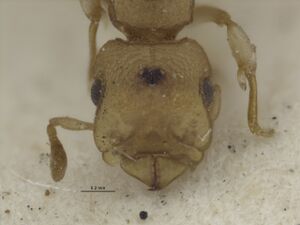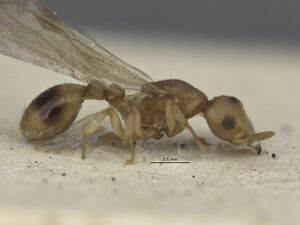Colobostruma leae
| Colobostruma leae | |
|---|---|

| |
| Scientific classification | |
| Kingdom: | Animalia |
| Phylum: | Arthropoda |
| Class: | Insecta |
| Order: | Hymenoptera |
| Family: | Formicidae |
| Subfamily: | Myrmicinae |
| Tribe: | Attini |
| Genus: | Colobostruma |
| Species: | C. leae |
| Binomial name | |
| Colobostruma leae (Wheeler, W.M., 1927) | |
This rare tropical species is found in rainforest and is likely arboreal (although nests have yet to be found).
| At a Glance | • Phragmotic |
Identification
This rare species is the only member of the genus with a phragmotic head (although Colobostruma lacuna, and to a lesser extent Colobostruma bicorna and Colobostruma unicorna, are subphragmotic). This distinctive head shape will readily separate this species from all others in the genus (Shattuck 2000).
Keys including this Species
Distribution
Latitudinal Distribution Pattern
Latitudinal Range: -16.58333° to -18.60000038°.
| North Temperate |
North Subtropical |
Tropical | South Subtropical |
South Temperate |
- Source: AntMaps
Distribution based on Regional Taxon Lists
Australasian Region: Australia (type locality).
Distribution based on AntMaps
Distribution based on AntWeb specimens
Check data from AntWeb
Countries Occupied
| Number of countries occupied by this species based on AntWiki Regional Taxon Lists. In general, fewer countries occupied indicates a narrower range, while more countries indicates a more widespread species. |

|
Estimated Abundance
| Relative abundance based on number of AntMaps records per species (this species within the purple bar). Fewer records (to the left) indicates a less abundant/encountered species while more records (to the right) indicates more abundant/encountered species. |

|
Elevation Range
| Species | Elevation (m asl) | |||||
|---|---|---|---|---|---|---|
| 200 | 400 | 600 | 800 | 1000 | 1200 | |
| Colobostruma leae | 60-70 | |||||
| Shading indicates the bands of elevation where species was recorded. Numbers are the percentage of total samples containing this species. | ||||||
Biology
Castes
     
| |
| Holotype of Colobostruma leae. Queen. . | Owned by Museum of Comparative Zoology. |
Nomenclature
The following information is derived from Barry Bolton's Online Catalogue of the Ants of the World.
- leae. Epopostruma (Colobostruma) leae Wheeler, W.M. 1927f: 32, fig. 40 (q.) AUSTRALIA (Queensland).
- Type-material: holotype queen.
- Type-locality: Australia: Queensland, Cairns district (A.M. Lea).
- Type-depository: MCZC.
- Combination in Colobostruma: Brown, 1948e: 118.
- Status as species: Brown, 1948e: 118; Taylor & Brown, 1985: 60; Taylor, 1987a: 22; Bolton, 1995b: 146; Shattuck, in Bolton, 2000: 44 (redescription).
- Distribution: Australia.
Type Material
- Epopostruma (Colobostruma) leae Wheeler, 1927: Holotype, queen, Cairns district, Queensland, Australia, A. M. Lea, Museum of Comparative Zoology.
Unless otherwise noted the text for the remainder of this section is reported from the publication that includes the original description.
Description
Worker
Shattuck (2000) - Anterior region of head extremely flattened and disc-like, the clypeus and frontal lobes expanded laterally into thin, sharply-edged flanges, the anterior sections of head separated from posterior sections by an angle at about the level of the eyes. Frontal lobes and lateral margins of clypeus smooth relative to the surrounding surface of the head. Mandibles broadly triangular. Hairs absent from dorsum of head. Posterior margin of head uniformly concave. Antenna with 6 segments, the scape weakly elbowed and without a subbasal lobe. Propodeum high, its posterior face approximately the same height as the petiolar node and with broad, thin lamellae. Lateral postpetiole drawn outwards into thin flange-like wings, the wings with translucent windows along both their anterior and posterior margins, the windows separated by a band of thickened integument and the anterior windows always smaller than the posterior windows. First gastral tergite very weakly and delicately sculptured , superimposed with low, closely spaced carinae on the anterior one-quarter. Body colour yellow, the gaster with an indistinct, broad medial band.
Etymology
Named for the collector of the type specimens.
References
- Bolton, B. 2000. The ant tribe Dacetini. Mem. Am. Entomol. Inst. 65: 1-1028 (page 44, see also)
- Brown, W. L., Jr. 1948e. A preliminary generic revision of the higher Dacetini (Hymenoptera: Formicidae). Trans. Am. Entomol. Soc. 74: 101-129 (page 118, Combination in Colobostruma)
- Burwell, C.J., Nakamura, A. 2020. Rainforest ants (Hymenoptera: Formicidae) along an elevational gradient at Eungella in the Clarke Range, Central Queensland coast, Australia. Proceedings of the Royal Society of Queensland 125: 43-63.
- Heterick, B.E. 2021. A guide to the ants of Western Australia. Part I: Systematics. Records of the Western Australian Museum, Supplement 86, 1-245 (doi:10.18195/issn.0313-122x.86.2021.001-245).
- Heterick, B.E. 2022. A guide to the ants of Western Australia. Part II: Distribution and biology. Records of the Western Australian Museum, supplement 86: 247-510 (doi:10.18195/issn.0313-122x.86.2022.247-510).
- Shattuck, S. O. 2000. Genus Colobostruma. Genus Mesostruma. Genus Epopostruma. Pp. 31-67 in: Bolton, B. The ant tribe Dacetini. Mem. Am. Entomol. Inst. 65: 1-1028.
- Wheeler, W. M. 1927f. The physiognomy of insects. Q. Rev. Biol. 2: 1-36 (page 32, queen described)
References based on Global Ant Biodiversity Informatics
- Taylor R. W. 1987. A checklist of the ants of Australia, New Caledonia and New Zealand (Hymenoptera: Formicidae). CSIRO (Commonwealth Scientific and Industrial Research Organization) Division of Entomology Report 41: 1-92.

